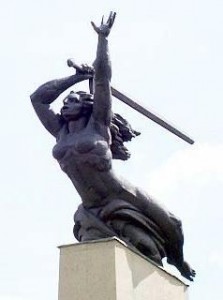 In 1964, Martin Heidegger wrote in his Remarks on Art—Sculpture—Space that the sculptor’s confrontation with their environment disrupted the smooth functioning of its spatial plan or setting. In other words, that sculpture challenged the very physicality of the social order and created a place apart: a place that disturbs the « seamless field over which proceeds the unending circulation of ersatz commodities. » Public monuments have always had a special place in Europe. However, they were never as controversial as following the Second World War during the reconstruction of bombed cities and the urban boom of the fifties and sixties. Heidegger’s analysis formed part of his critique of consumer culture, now it provides a useful philosophical lens through which we can begin to rethink and reassess the relationship between the beholder and the work of art.
In 1964, Martin Heidegger wrote in his Remarks on Art—Sculpture—Space that the sculptor’s confrontation with their environment disrupted the smooth functioning of its spatial plan or setting. In other words, that sculpture challenged the very physicality of the social order and created a place apart: a place that disturbs the « seamless field over which proceeds the unending circulation of ersatz commodities. » Public monuments have always had a special place in Europe. However, they were never as controversial as following the Second World War during the reconstruction of bombed cities and the urban boom of the fifties and sixties. Heidegger’s analysis formed part of his critique of consumer culture, now it provides a useful philosophical lens through which we can begin to rethink and reassess the relationship between the beholder and the work of art.
Papers that examine the role and different historical traditions of public sculpture throughout Europe will be enthusiastically welcomed. Together we will consider modern and contemporary sculpture from every angle : its technical construction, its relation to monuments, as architectural elements and components of public gardens and landscaping, as well as its significance as sites of contemplative refuge: as sources for renewal, literally and metaphorically.
Information about The Southeastern College Art Conference (SECAC), abstract guidelines and submission procedures is available at : http://www.secollegeart.org/conference
Please use SECAC’s online form and submit your abstract and CV no later than midnight on April 20, 2013.
Thank you,
Catherine Dossin, Purdue University, cdossin@purdue.edu, and Victoria H.F. Scott, EPCAF Director of Research, victoriahfscott@gmail.com
European Postwar and Contemporary Art Forum : https://sites.google.com/site/epcafcentral/

Leave a Reply
You must be logged in to post a comment.